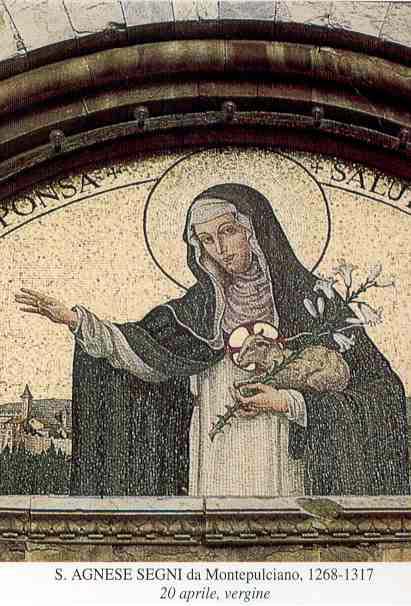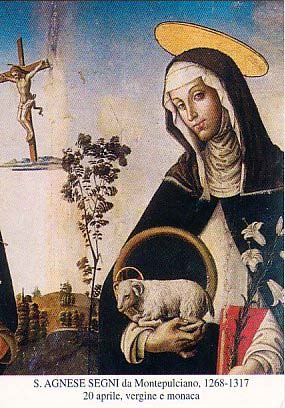인창동성당 게시판
|
4월20일 몬떼풀치아노의 성녀 아녜스♬AVE MARIA (C.Gounod) |
|---|
|
축일:4월20일 몬떼풀치아노의 성녀 아녜스 St. Agnes of Montepulciano OP V (RM) Sant’ Agnese Segni di Montepulciano Vergine Born:1268 at Gracchiano-Vecchio, Tuscany, Italy Died:20 April 1317 at the convent of Montepulciano of natural causes following a lengthy illness Beatified:1534 Canonized:1726 by Pope Benedict XIII Agnese = pura, casta, dal greco = pure, chaste, from the Greek
아녜스는 ’순수한’이란 뜻이다. 아녜스는 어린 나이에 수녀회에 들어가서, 최연소 원장이 된 수녀이다. 1298년, 그녀는 몬떼풀치아노에 수녀원을 설립해 달라는 초청을 받고, 도미니꼬회의 도움으로 이 사업을 성공시켰다. 아녜스는 놀라운 금욕 생활을 하였으며, 수많은 환시와 기적 그리고 다른 놀라운 일이 많았다고 한다. (성바오로수도회홈에서)
설교자회(도미니코회)의 영성 그리스도를 따름으로써 하느님과 이웃에 대한 사랑에 있어서 완성을 이루기 위하여, 우리는 자신을 수도회에 일치시키는 선서를 통하여 우리 자신을 하느님께 온전히 축성하며, 특히 새로운 방식으로 자신을 보편 교회에 바치며 하느님 말씀의 완전한 복음화를 위하여 온전히 바치는 것이다. (근본 회헌 § III)
사도들의 사명의 협력자들인 우리는 성 도미니코가 생각했던 생활 방식을 따라, 사도들의 생활을 본받아 공동 생활에서 한마음을 이루고, 복음적 권고[순명, 정결과 청빈]의 선서에 충실하며, 전례의 공동적 참여, 기본적으로 성체성사와 성무일도, 기도[묵상, 묵주기도와 천주의 모친이신 동정녀께 대한 신심 등]와 금욕에 열성을 가지고, 진리를 근면하게 공부하며, 꾸준히 규율을 준수[봉쇄, 침묵, 수도복 착용, 참회 고행으로 하는 일 등]한다. 이 요소들은 서로 긴밀히 결합되어 있으며, 서로 균형을 이루며 조화되고 서로를 풍요롭게 하여, 그 총체가 우리 수도회의 고유한 생활을 이루는 것이다. 즉 가장 완전한 사도생활은 풍부한 묵상에서부터 설교와 가르침이 나오는 것이어야 한다. (근본 회헌 § IV)
그러므로 우리 형제 토마스 아퀴나스는 도미니코회의 카리스마를 "관상하고 관상한 것을 전한다"로 요약하였는데, 이것은 우리의 소중한 모토가 되었다. (도미니코회홈에서)
*성 도미니코 사제 축일:8월8일.게시판1308번 *성 토마스 아퀴나스 사제 축일:1월28일.게시판1590번. ☞http://home.catholic.or.kr/gnbbs/ncbbs.dll/chinchang
♬AVE MARIA (C.Gounod)성요한 수도회
AGNES of Montepulciano
Memorial 20 April Profile Born wealthy. A pious child, at age six she began nagging her parents to join a convent. Admitted to the convent at Montepulciano at age nine. When her spiritual director was appointed abbess at Procena, she took Agnes with her. Agnes’s reputation for holiness attracted other sisters. Abbess at age fifteen after receiving special permission from Pope Nicholas IV. Agnes insisted on greater austerities in the abbey; she lived off bread and water, slept on the ground, used a stone for a pillow. In 1298 she returned to Montepulciano to work in a new Dominican convent. Prioress of the house the last seventeen years of her life. Pilgrim to Rome.
Many stories grew up around Agnes. Her birth was announced by flying lights surrounding her family’s house. As a child, while walking through a field, she was attacked by a large murder of crows; she announced that they were devils, trying to keep her away from the land; years later, it was the site of her convent. She was known to levitate up to two feet in the air while praying. She received Communion from an angel, and had visions of the Virgin Mary. She held the infant Jesus in one of these visions; when she woke from her trance she found she was holding the small gold crucifix the Christ child had worn. On the day she was chosen abbess as a teenager, small white crosses showered softly onto her and the congregation. She could feed the convent with a handful of bread, once she’d prayed over it. Where she knelt to pray, violets, lilies and roses would suddenly bloom. While being treated for her terminal illness, she brought a drowned child back from the dead. At the site of her treatment, a spring welled up that did not help her health, but healed many other people. Born 1268 at Gracchiano-Vecchio, Tuscany, Italy Died 20 April 1317 at the convent of Montepulciano of natural causes following a lengthy illness; legend says that at the moment of her death, all the babies in the region, no matter how young, began to speak of Agnes, her piety, and her passing; miracles reported at her tomb; body incorrupt; relics translated to the Dominican church at Orvieto in 1435 Beatified 1534 Canonized 1726 by Pope Benedict XIII
Sant’ Agnese Segni di Montepulciano Vergine
20 aprile Gracciano Vecchio, 28 gennaio 1268 - Montepulciano, 20 aprile 1317
Nata in anno incerto da famiglia nobile di Montepulciano, a nove anni e ? diremmo oggi ? in collegio dalle monache, dette “Saccate” dal loro particolare abito. E li poi rimane. Cinque anni dopo accompagna la maestra delle novizie suor Margherita a Proceno (Viterbo) per fondarvi un nuovo monastero. Passa un altro anno e incredibilmente ne diventa superiora: lei, Agnese, a quindici anni, con approvazione pontificia; e "per la visibile forza esercitata dalla sua santita", come scrivera piu tardi fra Raimondo da Capua nella sua entusiastica biografia di Agnese. Una santita di cui parlano tutti, e che poi i cittadini di Montepulciano “sequestrano” per se: insistono, premono, e infine riescono a farla tornare tra loro da Proceno, per fondare nel borgo di Gracciano un monastero, nel 1306. E dedicato a Santa Maria Novella, si alimentera della spiritualita domenicana e Agnese ne sara la badessa fino alla morte.
Etimologia: Agnese = pura, casta, dal greco Emblema: Giglio
Agnese Segni nacque il 28 gennaio 1268 a Gracciano, piccolo borgo nei pressi di Montepulciano. Agnese senti fin da piccola il fascino delle cose spirituali e durante una visita con i suoi familiari a Montepulciano vide le suore del "sacco", chiamate cosi per il rustico sacco che vestivano. nove anni chiese di essere ammessa in convento dove fu subito accolta. A Montepulciano resto solo il tempo necessario per la formazione religiosa di base. Nel 1233, gli amministratori del castello di Proceno, feudo orvietano (oggi in provincia di Viterbo), si recarono a Montepulciano per chiedere l’invio di alcune suore nel loro territorio e Agnese fu tra le prescelte. Agnese, seppur molto giovane, fu nominata superiora del monastero, per le sue doti di umilta e il grande amore per la preghiera, per lo spirito di sacrificio (per quindici anni visse di pane ed acqua) e per l’ardente amore verso Gesu Eucarestia. A Proceno Agnese ricevette dal Signore il dono dei miracoli: gli ossessionati venivano liberati solo al suo avvicinarsi, moltiplico in piu occasioni il pane e malati gravi riacquistarono la salute. Ma nei ventidue anni che resto a proceno non mancarono le tribolazioni: gravi sofferenze fisiche la tormentarono per lunghi periodi. Nella primavera del 1306 fu richiamata a Montepulciano, dove fa iniziare la costruzione di una chiesa, come chiestogli da Maria in una visione avuta alcuni anni prima in cui la Vergine le dono tre piccole pietre a questo scopo. E’ un’altra visione, questa volta di san Domenico, che spinge Agnese a fare adottare alle sue suore la regola di sant’Agostino e ad aggregarsi all’ordine domenicano per l’assistenza religiosa e la cura spirituale. Numerose furono le occasioni in cui Agnese intervenne in citta come paciere e risolutrice delle controversie nelle lotte tra le famiglie nobili della localita. Nel 1316 Agnese, su invito del medico e dietro le pressioni delle consorelle si reco a Chianciano, per curarsi alle terme. La sua presenza fu d’aiuto ai numerosi malati presenti nella localita e Agnese opero numerosi miracoli, ma le cure termali non portarono alcun giovamento alla sua malattia, che peggioro. Rientrata a Montepulciano, fu costretta a letto. Ormai in punto di morte Agense rincuorava le consorelle invitandole a rallegrarsi perche per lei era giunto il momento dell’incontro con Dio, cio avvenne il 20 aprile 1317. I frati e le suore domenicane volevano imbalsamare il corpo di Agnese e per questo motivo furono inviati dei signori a Genova per acquistare del balsamo, ma cio non fu necessario: dalle mani e dai piedi della santa stillo infatti un liquido odoroso che impregno i panni che coprivano il corpo della santa e ne furono raccolte alcune ampolle. L’eco del miracolo, richiamo numerosi ammalati, che desideravano essere unti dall’olio miracoloso. Come scrisse il beato raimondo da Capua, a distanza di cinquant’anni dalla morte della santa, il suo corpo era ancora intatto, come se Agnese fosse appena morta, e molti erano i miracoli di guarigione che avvenivano nella chiesa, che ormai era conosciuta come "chiesa di sant’Agnese", ma si guariva anche non appena fatto voto di recarsi a visitare la stessa. Di questi miracoli si ha anche una pubblica registrazione fatta da notai gia a partire da pochi mesi dopo la morte della santa.
Autore: Maurizio Misinato
Agnes of Montepulciano, Saint (c.1268-1317) Prioress. Born near Montepulciano, Italy; died there. She entered a monastery at nine, became prioress at fifteen, and founded a Dominican convent at Montepulciano, which she governed until her death. Canonized, 1726. Relics at Orvieto. Feast, 20 April. New Catholic Dictionary - Catholic Encyclopedia; Butler
Agnes of Montepulciano, OP V (RM) Born in Gracchiano-Vecchio, Tuscany, Italy, in 1268; died at Montepulciano, Tuscany, on April 20, 1317; canonized by Benedict XIII in 1726. Agnes was not a child martyr like her Roman patroness but she exhibited the same simplicity, and some of her best-known legends concern her childhood. Her birth into the wealthy de Segni family was announced by great lights surrounding the house where she was born. From her infancy she was especially marked for dedication to God: she would spend hours reciting Pater Nosters and Ave Marias on her knees in the corner of some room.
By the time Agnes was six, she was already urging her parents to let her enter the convent. When they assured her that she was much too young, she begged them to move to nearby Montepulciano, so she could make frequent visits to the convent. Because of the local political instability, her father was unwilling to move from his safe haven but did allow his little girl to visit with the sisters occasionally.
On one of these visits an event occurred that all the chroniclers record as being prophetic. Little Agnes was traveling in Montepulciano with her mother and the women of the household, and, as they passed a hill on which stood a bordello, a flock of crows swooped down and attacked the girl. Screaming and plunging, they managed to scratch and frighten her badly before the women drove them away. Upset by the incident, but devoutly sure of themselves, the women said that the birds must have been devils, and that they resented the purity and goodness of little Agnes, who would one day drive them from that hilltop. Agnes did, in fact, build a convent there in later years.
When she was nine, Agnes insisted that the time had come to enter the convent del Sacco. She was allowed to go to a group of Franciscans in Montepulciano, whose dress was the ultimate in primitive simplicity: they were known, from the cut of the garment, as the Sacchine or ’sisters of the sack.’ The high-born daughter of the Segni was not at all appalled at the crude simplicity with which they followed their Father Francis; she rejoiced in it. Her religious formation was entrusted to an experienced older sister named Margaret, and Agnes soon edified the whole house by her exceptional progress. For five years she enjoyed the only complete peace she would ever have; she was appointed bursar at the age of 14, and she never again was without some responsibility to others.
During this time Agnes reached a high degree of contemplative prayer and was favored with many visions. One of the loveliest is the one for which her legend is best known: the occasion of a visit from the Blessed Virgin. Our Lady came with the Holy Infant in her arms, and allowed Agnes to hold Him and caress Him. Unwilling to let Him go, Agnes hung on when Our Lady reached to take Him back. When she awakened from the ecstasy, Our Lady and her Holy Child were gone, but Agnes was still clutching tightly the little gold cross He had worn on a chain about His neck. She kept it as a precious treasure.
Another time, Our Lady gave her three small stones and told her that she should use them to build a convent some day. Agnes was not at the moment even thinking about going elsewhere, and said so, but Our Lady told her to keep the stones--three, in honor of the Blessed Trinity--and one day she would need them.
Some time after this, a new Franciscan convent opened in Procena, near Orvieto, and the sisters there asked the ones of Montepulciano to send them a mother superior. Sister Margaret was selected, but stipulated that Agnes must be allowed to come to help her in the foundation of the new community. There Agnes served as housekeeper--a highly responsible position for a 14-year-old! Soon many other girls joined the convent at Procena simply became they knew that Agnes was there.
To the distress of young Agnes, she was elected abbess. Since she was only 15, a special dispensation was needed--and provided by Pope Nicholas IV--to allow her to take the office. On the day when she was consecrated abbess, great showers of tiny white crosses fluttered down on the chapel and the people in it. It seemed to show the favor of heaven on this somewhat extraordinary situation.
For 20 years, Agnes lived in Procena, happy in her retreat and privileged to penetrate the secrets of God in her prayer. She was a careful superior, as well as a mystic; several times she worked miracles to increase the house food supply when it was low. The nun’s self-discipline was legendary. She lived on bread and water for fifteen years. She slept on the floor with a stone for a pillow. It is said that in her visions angels gave her Holy Communion.
Once her visions of Christ, the Blessed Virgin, and angels had become known, the citizens of Montepulciano called her back for a short stay. She went willingly enough, though she hated leaving the peace of her cloister for the confusion of travelling. She had just settled down, on her return, with the hope that she had made her last move and could now stay where she was, when obedience again called her back to Montepulciano--this time to build a new convent. A revelation had told her that she was to leave the Franciscans, among whom she had been very happy, and that she and her future sisters should become Dominicans.
In 1306, Agnes returned to Montepulciano to put the Lord’s request into action: she was to build a convent on the former site of the brothels. All she had for the building of the convent were the three little stones given her by the Blessed Virgin, and Agnes--who had been bursar and knew something about money--realized that she was going to have to rely heavily on the support of heaven in her building project.
After a long quarrel with the inhabitants of the hilltop she wanted for her foundation, the land was finally secured, and the Servite prior laid the first stone, leaving her to worry about from where the rest of the stones would come. Agnes saw the project to its completion. The church and convent of Santa Maria Novella were ready for dedication in record time, and a growing collection of aspirants pleaded for admittance to the new convent.
Agnes had become convinced that the community must be anchored in an established Rule in order to attain permanence. She explained that the rule was to be Dominican, not Franciscan. All the necessary arrangements were made, she was established as prioress, the Dominicans agreed to provide chaplains and direction, and the new community settled down. They had barely established the regular life when one of the walls of the new building collapsed. It was discovered that the builders had cheated, and that the whole convent was in danger of falling on top of them. Agnes met the new problem with poise. She had many friends in Montepulciano by this time, and they rallied to rebuild the house.
When the convent was once again completed, and had become, as hoped, a dynamo of prayer and penance, Agnes decided to go to Rome on pilgrimage. It is interesting to note that Second Order convents of the 14th century were so flexible in the matter of enclosure. She made the trip to Rome and visited the shrines of the martyrs. The pope was at Avignon, so she did not have the happiness of talking to him. But she returned to Montepulciano full of happiness for having seen the holy places of Rome.
At the age of 49, Agnes’s health began to fail rapidly. She was taken for treatment to the baths at Chianciano--accompanied, as it says in the rule, by ’two or three sisters’--but the baths did her no good. She did perform a miracle while there, restoring to life a child who had fallen into the baths and drowned.
Agnes returned to Montepulciano to die in the night. When she knew she was dying after a long and painful illness, Agnes told her grieving nuns that they should rejoice, for, she said, "You will discover that I have not abandoned you. You will possess me for ever." The children of the city wakened and cried out, "Holy Sister Agnes is dead!" She was buried in Montepulciano, where her tomb soon became a place of pilgrimage.
One of the most famous pilgrims to visit her tomb was Saint Catherine of Siena, who went to venerate the saint and also, probably, to visit her niece, Eugenia, who was a nun in the convent there. As she bent over the body of Saint Agnes to kiss the foot, she was amazed to see Agnes raise her foot so that Catherine did not have to stoop so far!
In 1435, her incorrupt body was translated to the Dominican church at Orvieto, where it remains today. Clement VIII approved her office for the use of the order of St. Dominic, and inserted her name in the Roman Martyrology (Attwater, Benedictines, Bentley, Dorcy, Encyclopedia, Farmer, Husenbeth, Walsh).
In art, Saint Agnes is a Dominican abbess (white habit, black mantle) with a lamb, lily, and book. She might also be portrayed (1) gazing at the Cross, a lily at her feet, (2) with the Virgin and Child appearing to her; (3) with the sick healed at her tomb (Roeder); (4) with Saint Catherine of Siena; or (5) as patroness of Montepulciano, of which she holds a model in her hand. Tiepolo presents Agnes as one of the saints surrounding the Blessed Virgin in the Jesuit church at Venice, Italy (Farmer). She is venerated at Montepulciano (Roeder).
|





